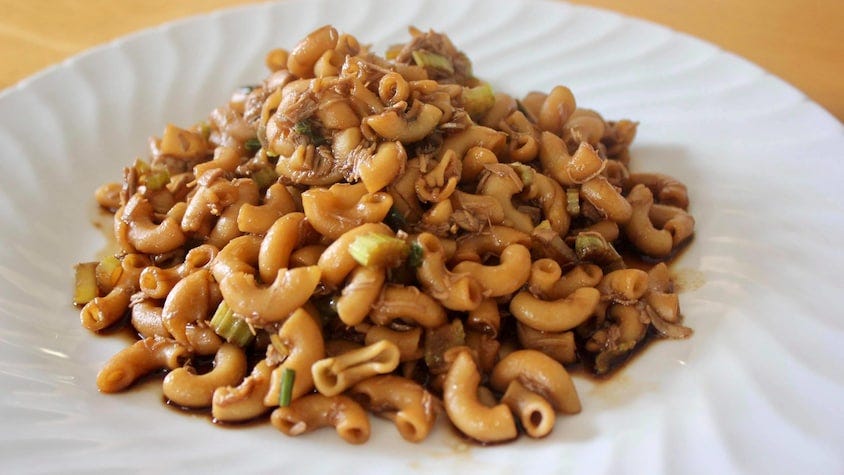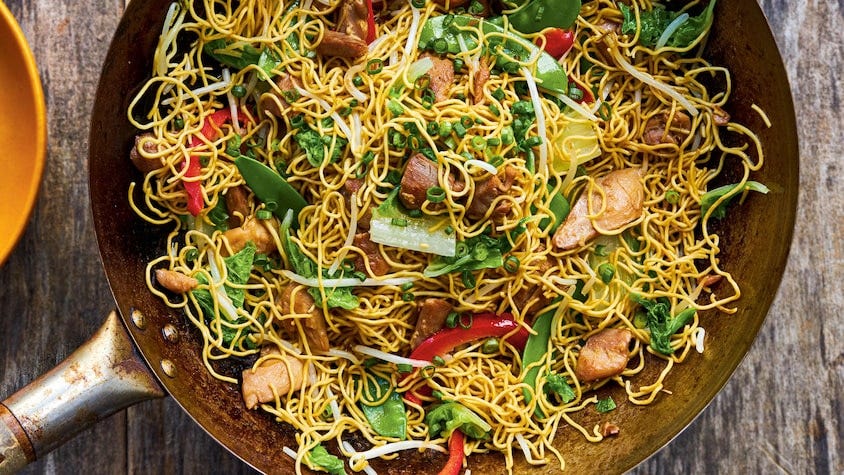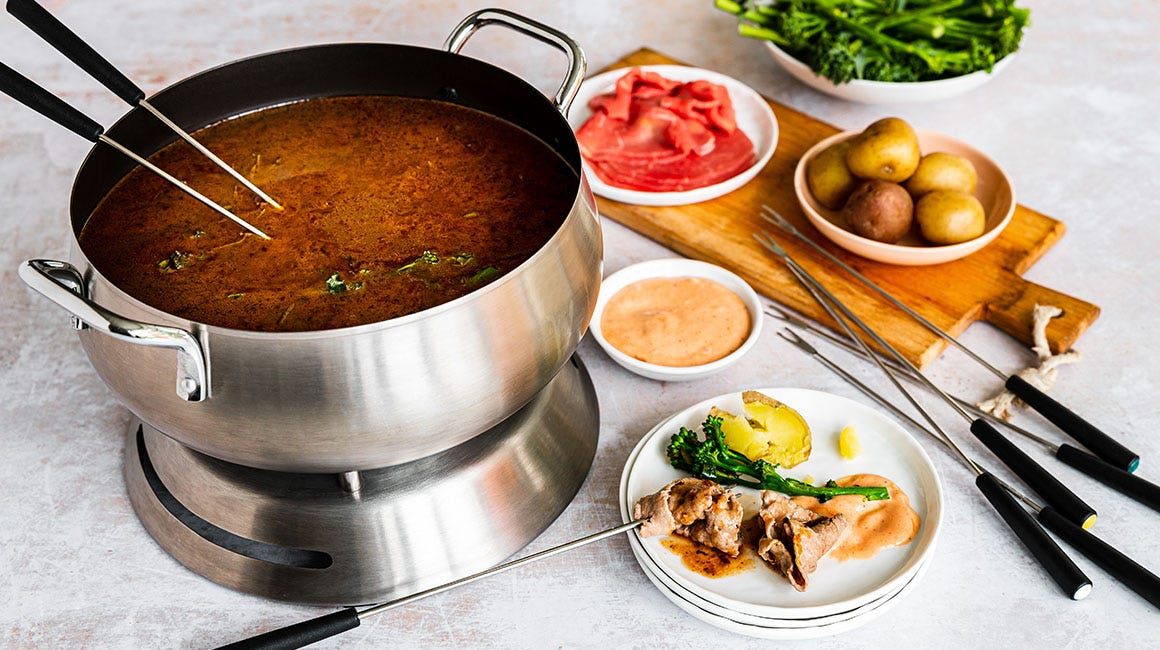Chinese Noodles, Swedish Tacos, and Other Authenticity Puzzles
On food, categories, and being tricked 🥡
In the early days of our relationship, my partner — who is of Chinese descent, although he’s never been in Asia and grew up in Africa — once suggested that we make Chinese noodles. I was, how to put this, not enthused. Chinese noodles were probably my least favorite dish in the world, and I believe I made a face, or said some words, to that effect. My partner was confused: how could Chinese noodles be anyone’s least favorite dish?
It soon came to light that we were talking about vastly different things. To me the words “Chinese noodles” (or, to render the conversation more faithfully, “nouilles chinoises”) referred primarily to this:
A cheap dish of macaroni, served with soy sauce and little bits of chicken and (ugh) celery, that I used to eat growing up. But my partner was instead referring to something like this, which I might have instead called chow mein:
As I would discover that night, chow mein is far more delicious than Quebec-style nouilles chinoises. It is certainly more authentic. Now and for the rest of my life, I shall be a purist, telling anyone who wants to hear that they should stop making disgusting celery-laden soy sauce macaroni and make real noodles instead. (Not that I know anyone who still commonly eats that.)
But authenticity is not necessarily correlated with quality, right? Another common Quebec pseudo-Chinese dish is fondue chinoise, which neither I nor Wikipedia know how to translate, because the English word fondue refers to Swiss-style cheese fondue, which fondue chinoise is not, while hot pot evokes the actual Chinese version, which fondue chinoise is quite far from. Like the soy sauce of the macaroni dish, fondue chinoise has some Chinese inspiration, specifically the idea of dipping meats in a communal pot. The broth may (but also may not) be vaguely Eastern. For the most part, however, this is a Western dish, using Western fondue forks (as opposed to chopsticks and strainer scoops), Western sauces (often mayonnaise- or mustard-based), and Western side dishes (such as potatoes).
I’ve had authentic Chinese hot pot too, and I like it a lot. But fondue chinoise holds a special place in my heart. It is the dish of special occasions, of family reunions, of deciding to be fancy for one evening. It is inauthentic, but, to me, better.
Or perhaps we should just say it is authentic in its own right, in a different frame of reference that includes Quebec but not China. I could certainly imagine being disappointed at someone who made fondue chinoise wrong.
Likewise, I could imagine a chef taking the macaroni nouilles chinoises as a base and turning it into something far tastier, but without making it more authentically Chinese. The result would be inauthentic with respect to either culture, but it would be better than the authentic-with-respect-to-Quebec dish I used to have.
Authenticity is not necessarily positive, then, but it often is. Why? Why do we care?
The answer varies depending on which kind of authenticity we’re talking about. The word means something different in music (where it refers to performing a piece as it was intended by the original composer, or on period instruments, etc.), in the visual arts (where it might mean being made by the original artist instead of being a copy), and so on. To stay in the realm of food, let’s look at what the philosopher Matthew Strohl says in his essay On Culinary Authenticity. He identifies five categories of reasons to value authenticity (the italics indicate potentially problematic reasons):
Aesthetic reasons: cultural taste preferences, alignment with cultural taste preferences, setting a baseline for comparison, using as a basis for creative deviation, category-dependent aesthetic features, excessive rigidity
Personal reasons: nostalgia, personal attachment
Educational reasons: curiosity, independent interest in the culture or context
Cultural reasons: pride in distinctness, community bonding, tradition, nativism, nationalism
Social reasons: social signaling, friendship, Otherness fetishism
Strohl doesn’t dwell too long on the latter four, probably because they aren’t very mysterious. The reasons we care about authenticity are often simple enough, though it’s still worthwhile to illustrate them with anecdotes.
When I lived in the small city of Uppsala, Sweden, I learned three things about Mexican food. #1) Mexican food is, ironically enough, Sweden’s national dish. Every supermarket has a wide alley of Mexican food products. And many Swedish families have a tradition of Taco Friday, or Taco Fredag, in which they relax at home watching TV and eating tacos. #2) None of the Mexican food in Swedish supermarkets or Taco Friday is authentically Mexican. It is, perhaps unsurprisingly, more akin to Tex-Mex, but with its own Swedish spin, like using cucumber. Unlike most Mexican cuisine, Swedish-Tex-Mex tacos use hard taco shells, and it is impossible to get soft corn tortillas in a regular Swedish supermarket.

At the time I didn’t know what actual tacos were: back home, the tacos I ate growing up were pretty much the same Tex-Mex stuff. But, once, my friends and I visited Stockholm, and we went to a Mexican restaurant run by Mexican immigrants. One of my friends, who is Mexican herself, was extremely excited. She would at last have proper Mexican food! We ate the authentic tacos, and they were delightful, and I was enlightened: now I knew what real Mexican food was (that’s #3). Meanwhile, my friend asked the restaurant staff if she could buy a pack of soft corn tortillas from them so she could bring them back to the tortilla-barren city of Uppsala. Finally she’d be able to cook the real thing at home. She had craved authenticity for personal and cultural reasons; and I enjoyed the authenticity for educational and social ones.
What remains is the aesthetic reasons. Those are more abstract, dealing with concepts like categories and taste preferences. Strohl discusses them at length, for instance pointing out that our enjoyment of a thing depends on expectations, and those expectations in turn depend on category membership, i.e., authenticity. To cite an example from the paper,
a custard without a crisp top layer that is perceived as a crème brûlée might have the negative aesthetic property of lacking texture, whereas if the same dish is perceived as a flan, it might have the positive aesthetic property of being silky.
This seems right, but I am not completely satisfied. Why exactly do we care about food categories?
This is a good example of why I tend to view “aesthetics” or “beauty” as lazy explanations for anything. Sure, I can describe my enjoyment of proper Chinese chow mein by saying “it’s beautiful,” but it necessarily is beautiful for some reason. Beauty is an emergent property of the chow mein and myself and the relationship between us. If I see beauty in authentic chow mein, that’s because the chow mein provides me with something else that I care about.
So we turn to evolutionary reasons, as one does.
There is most likely some deep evolutionary psychology that explains caring about categories. Having a mental model of “poisonous plants” vs. “edible plants” is a good way to improve one’s survival odds. The great ape that cares about a dish of Rootsus nontoxicus being “authentically” Rootsus nontoxicus, as opposed to the closely related but deadly Rootsus toxicus, is more likely to pass on his genes. And although the great ape doesn’t know about Latin names from Linnaean taxonomy, his brain contains some kind of machinery to be able to classify plants in either category.
But evolutionary psychology is fraught, impossible to verify, prone to just-so stories. Another part of the answer must comes from cultural evolution; that is, memes.
Each human kid must learn how the world works. One thing they learn fairly early is that other people are out there to trick them. Kids learn this from facetious dads who randomly hide objects around. They learn this from schoolmates who ask them to “borrow” something and then never give it back. They learn this from online scammers who promise them the riches of a recently deceased Nigerian prince.
Along the way, we develop pretty good cultural defenses against being tricked. Every time someone shows us something, anything, there’s a little part of us that goes, “can I trust that?” Can I trust this job offer, this expression of friendly support, this underpriced piece of clothing, this work of art, this dish of chow mein? We quickly learn to do the same classification task that our great ape was doing, but with every single kind of thing. After all, we can’t know in advance whether it’s worth caring about being tricked or not in any particular situation. Sometimes our judgment is quick enough, for instance if we already have reason to trust the person or if we’ve dealt with similar cases in the past. But ultimately we always ask: Toxic or nontoxic?
Authenticity is what happens when this culturally evolved defense system is still on, even though it’s clear that we don’t really need to avoid danger. It’s not hazardous to buy a fake painting, if it’s a reasonably well-made forgery and it’s costing you little: it’s going to look just as fine in your living room. It’s not risky to eat the Swedish-Tex-Mex version of tacos, or the Quebec version of Chinese hot pot: it’s going to taste good and sustain you just as well, provided it doesn’t contain any Rootsus toxicus. Yet a part of us still asks: can I trust it?
What I am presenting is a hypothesis: I’m not sure that this defense reaction is what actually happens. But it seems plausible to me that authenticity, just like beauty and other general-purpose capabilities of the human mind, works somewhat like that. A partly psychological, partly cultural system to distinguish between good and bad, and which evolved in response to a few specific situations but then can be effortlessly applied to far more.
Beyond food, my amateur explanation of authenticity helps us make sense of other situations.
For instance, why are video games frowned upon by many? Because they’re not authentic: they take place in artificial environments made for the sole purpose of enjoyment, which is worryingly similar to someone telling a story in order to embezzle us. Spending hours in a virtual place seems worse in a sense than spending them “in real life”; completing the Pokédex by catching all Pokémon seems lower-status than collecting real butterflies.
We can still enjoy video games, of course, because they contain a lot of cool stuff, but they’re clearly less authentic, less trustable. There might be a bug in it, or a design flaw. There can’t be bugs or design flaws in reality — it is what it is.
Everything can be interpreted as being on an authenticity spectrum. Take sports watching. Such an activity has always been a puzzle to me, because it seems repetitive and inauthentic: sports are artificial, contrived situations, just like video games, and yet they are less stimulating in terms of storytelling and gameplay. But they are more authentic than video games anyway, because they involve real people doing a thing with their whole bodies, none of which can be easily faked. Besides, the stakes are real: no one knows in advance who will win. We can “trust” sports more than we can a fictional narrative.
And yet sports are less authentic than real conflict, like war, whose stakes are excruciatingly more real. We can “trust” war: either you survive it or you don’t.
Fortunately, sports have other desirable properties, such as not getting anyone killed. And we go back to my point at the beginning of the post, which was that authenticity is not always desirable. Matthew Strohl calls it “value-neutral.” If authenticity is at its core a simple matter of categorization, then it wholly depends on whether the categories contain good things or not.
If we do have some kind of anti-trick system that’s always on, then we need to be careful about when and how we pay attention to it. We don’t want to fall into traps like excessive rigidity, or caring too much about categories. It is written that “the categories were made for man, not man for the categories”; and that’s why one should strive to get their tacos, or hot pot, or nouilles chinoises to be just as authentic as one desires; no more, no less.
I agreed to do a bit of cross-promotion with Snipette, a publication that seeks to be both literary and academic. I like their approach of serving “interconnected stories of things that are seemingly uncorrelated.” The Last Sorcerer is a story that is emblematic of their content and form, but they also write about the implications of AI language models on potentially breaking down barriers in human-to-whale communication, or Al Capone’s role in bringing the world fresh bottled milk.














Loved to read this piece! I never thought about authenticity like that... I have listened a lot of talks (online) by different people - specially Gabor Mate ... who is all about authenticity. I understand fully how he uses it but I love how you open the concept....Thank you so much for this new perspective....Sage
A friend brought this to my attention. I appreciate the nuanced discussion of
authenticity and thanks considering my work on the topic so closely!